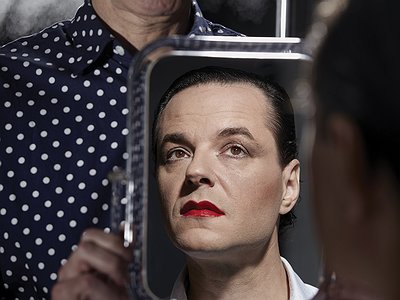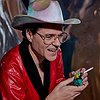Part 1
Name: Matias Aguayo
Nationality: Chilean
Occupation: DJ/Producer/Musician
Current Release: Sofarnopolis on Crammed Discs
Recommendations: I can’t give recommendations here but I can share some pieces of art that have had an impact on me: The movie “Gold Rush” by Charlie Chaplin / “Odd man out” by Carol Reed / the painting “La Toilette” by Toulouse Lautrec/ Iannis Xenakis / Le Corbusier Philips Pavillon / The Love & Rockets comic series by Los Brothers Hernandez / Bulgakov’s “Master and Margerita”.
Website / Contact: If you enjoyed this interview read more and keep up to date via his website
www.matiasaguayo.com/desdemonas
When did you start writing/producing music - and what or who were your early passions and influences? What is it about music and/or sound that drew you to it?
It was radio that initiated my first musical adventures. Turning its dial was a way of travelling with the mind, specially moving in the ultra-short-wave ranges with its strange synthesizer-like sounds that seemed to come from outer space, mysterious Morse codes and voices in strange languages from far away, futuristic sounds and also - cold war: secret intelligence codes in German, robotically read.
I had a boom-box and the ability to record these sounds on tape but also to record my own musical experiments which was my main tool. And I loved the effect of springs, I used to put my head in the washing machine and sing to get that reverberation they produce, or I would hit the springs of the desktop lamp or slide along them with a screwdriver to play percussion or create other sounds. Later I would, from time-to-time, borrow a 4-track recorder from a friend, which changed everything as I could finally could start doing overdubs and combine the radio sounds with my voice, speeding up and slowing down the tempo, layer voices etc. I would spend a lot of time doing that. I still have many tapes with these recordings.
Sounds always translated to me as the most direct connection to my imagination and a way of creating the sensation of traveling in space and time.
For most artists, originality is first preceded by a phase of learning and, often, emulating others. How would you describe your own development as an artist and the transition towards your own voice? What is the relationship between copying, learning and your own creativity?
I started making my own creations right from the start - without really knowing how to play anything, and then slowly added more knowledge by studying instruments and technique. By doing things wrongly I invented my own way of working. It was learning by doing.
My approach wasn’t driven much by emulation of other artists either, as I always thought them to be so far and out of reach and so much better with all the possibilities and knowledge they seemed to have, and those big studios. For me, it was more as if I was playing, just acting as if I was a musician, or a radio broadcasting service, etc while recording. I would imitate the 808 or LM claps I knew from songs on the radio by hitting my hands on my lap, close to the microphone and imitate scratching sounds with the voice. It was all about imagination, because of my extremely reduced accessibility to music. There was no serious record shop in town, no extensive record collections around etc.
Years later, in the times of the Techno and House crazes, I was already living in Cologne, and I was much too intimidated to share my music, as everything sounded so developed and modern, and the kids I met that were doing music were talking about stuff like Low Pass filters and LFOs. That sounded like very complex stuff to me that I would surely never be able to understand.
Fortunately, I met Dirk Leyers and we formed the project “Closer Musik”. Our first technical steps were very much based on using a program on the Commodore Amiga that we had both used before in our teenage years, which was already outdated at the time. It only provided four channels of audio, which is why we worked with two Amigas – so we’d have eight channels in total.
We looked up to artists or labels like Elektro Music Department or Panasonic, and we tried to create something similar as if we would belong to the same schools of thought, but we could never keep up with the dogmatic or conceptual spirit that we wished to achieve.
Looking back this sounds funny to me, and I can see a development of musical liberation that starts from trying to understand how things are supposed to be and finishing up somewhere else.
On emulation though, not so long ago, I tried to do a genuine cover version of Missy Eliotts’ “The Rain”, and that was super fun. I learned a lot about how she uses the voice.
What were your main compositional- and production-challenges in the beginning and how have they changed over time?
I guess it was learning to be outside of myself in the musical process; to have – in my mind – my ear on the other side. By which I mean, understanding a composition of mine as the listener. That took a lot of time and experience, and it’s wonderful to experience. You can reach levels where you can watch yourself playing in disbelief, hearing what comes out and the instruments seem to be playing themselves.
In terms of composition I moved steadily away from chord progressions and pop/song composition rules and towards what I heard in techno, psychedelic music or classic cumbia for example.
I wanted to invent melodies out of the accent and rhythms that are developed through speech in everyday life and detune the voice on purpose. I wanted to get as far away from pop as possible, and also, to find emotional expression not only in melody but especially in rhythm.
What was your first studio like? How and for what reasons has your set-up evolved over the years and what are currently some of the most important pieces of gear for you?
I don’t think of the music spaces that I’ve used as studios, because their setup was ever-changing and the acoustic conditions were never ideal and quite improvised. And even The District Union – my studio in Berlin – is not really a studio but a music-making environment with no ideal acoustic situation. It’s a space that’s fun and an inspiring place to work.
The setup was thought out by Philipp Gorbachev and me and we had this idea to play with an avant-garde-inspired idiosyncratic approach. For example, we built a “satellite system” of booths that form a circle towards a mixing console in the middle, as an alternative to the classic studio environment. Ours is more like a flying saucer or terminal one of Charles de Gaulle airport. We did a lot of sketches that look as if we were working on a space station – it’s a fantastic environment.
My favourite gear changes. It depends on what project I am working on, but at the moment it’s the Tempest drum machine, the “Mona” and the Nord drums. The “Mona” is a keyboard I can strap around my shoulders. A friend helped me build it. It’s basically a Critter & Guitari pocket piano that I play connected to several stomp-boxes. The name comes from a song by Bo Diddley, who built his own guitars. One even had drum pads!
How do you make use of technology? In terms of the feedback mechanism between technology and creativity, what do humans excel at, what do machines excel at?
The machines we use are musical instruments, especially the ones that don’t need to be updated all the time. I develop an almost emotional relationship with them. It’s a fun projection that you enter this space called a studio and all these machines are looking at you and just by turning them on, there is already sound; a buzz noise, they seem alive. It is there, in the purity of these machines that you can find many things and explore the depths of reverberations and feedbacks and unique sounds that lie somewhere in something that could be interpreted as the machine’s breath or heartbeat. I perceive every machine or tool as a new situation to which I have to react in a poetical way, and develop a specific gesture that I can relate to it. It feels best when I have the impression that I’m making use of it in an unusual way. It is like recognising the qualities of someone that are ignored by others. The lifeless machine seems to be thankful for that, by emanating sounds of ecstasy.






